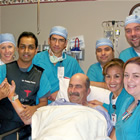| << To Blog Home >> | |
|
|
May 2, 2010 -- 1:05pm EDT Stents and Angioplasty from the Wrist: Texas
Style When Dr. Patel arrived in Houston, radial procedures were not well-known. In fact, as he told me:
Not only were the physicians and staff unfamiliar with doing these complicated interventions from the wrist artery -- the patients were as well:
"Well-known cardiologists around the world" is correct -- in other countries, up to 50% of all catheter-based coronary procedures are done from the transradial wrist approach. The reason the U.S. is so far behind (only 5% of procedures are done this way here) has to do with training. Cardiologists learn the femoral approach in their fellowships and, unless they fortuitously land a position in a teaching program like Dr. Coppola's, they are unfamiliar with the radial approach. To learn it, they have to go back to the drawing board, attend a specialized training course, taking them out of their practice for a short while, and they have to do the procedure often enough to overcome the learning curve. Of course, once they do learn, they become sought after, as Dr. Patel has in the hospitals where he practices. His first radial procedure is shown in the photo above (note the smiling patient!) and a story in the local paper about it made a big difference. Suddenly patients were interested and referring physicians were sending him their patients. That was two years ago; he has now done over a thousand radial procedures. As he told me:
There's been such interest that Dr. Patel is now running monthly transradial training courses for other cardiologists. As more cardiologists learn the technique and more patients find out that they may not have to lie flat on their backs for hours, use of the transradial approach in the U.S. is sure to make substantial increases. You can read my complete interview with Sanjay Patel, MD, FACC in Angioplasty.Org's Transradial Center. |
|


 Two
years ago interventional cardiologist Dr. Sanjaykumar Patel joined
the Sadler Clinic in The Woodlands, a suburb of Houston. He had taken
his
Fellowship at St. Vincent's Hospital in New York, with Dr. John Coppola
as his mentor. Dr. Coppola is a strong advocate of the transradial
approach, in which angioplasty and stents are delivered to the coronary
arteries via a small puncture in the wrist. (Most of these procedures
in the United States are done through the femoral artery in the groin.)
You can
Two
years ago interventional cardiologist Dr. Sanjaykumar Patel joined
the Sadler Clinic in The Woodlands, a suburb of Houston. He had taken
his
Fellowship at St. Vincent's Hospital in New York, with Dr. John Coppola
as his mentor. Dr. Coppola is a strong advocate of the transradial
approach, in which angioplasty and stents are delivered to the coronary
arteries via a small puncture in the wrist. (Most of these procedures
in the United States are done through the femoral artery in the groin.)
You can